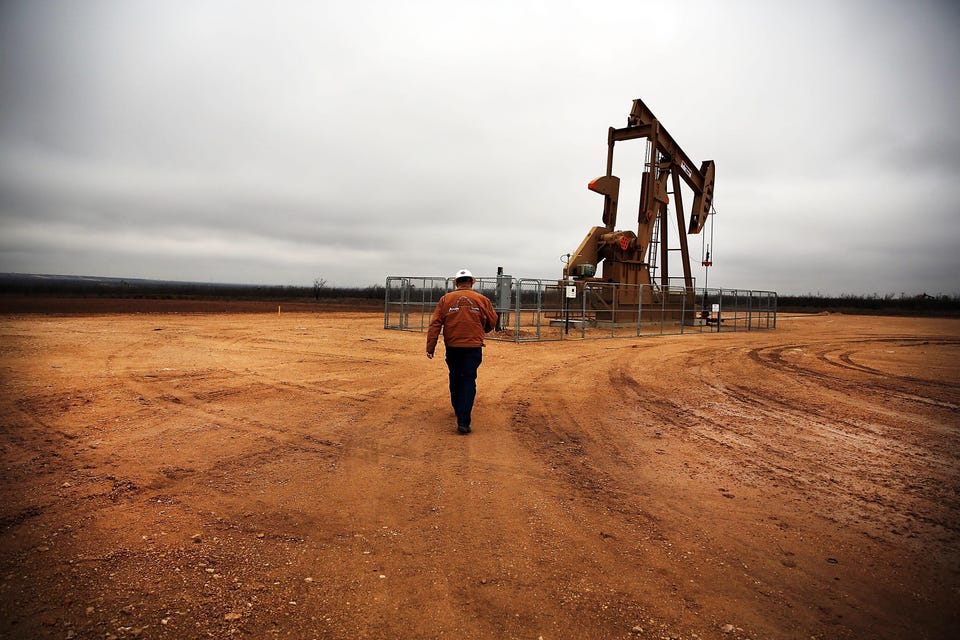The Disappearance Of Good Rock Worries Oil Markets


Oil companies drilling in Texas’ Permian Basin are having to adapt to falling output as acreage with … [+] the “top rock” runs out. (Photo by Spencer Platt/Getty Images)
Getty Images
American shale has been critical to keeping up with growth in global oil demand for the last decade, but that may not be the case for much longer.
Shale oil production continues to grow, but growth rates are slowing as the sector runs out of the most productive acreage.
Growth rates will fall as companies move into more prospective areas, particularly in the Permian Basin, long the source of U.S. production growth.
The result is that domestic oil production could peak sooner than expected, removing the most important non-OPEC source of supply growth for oil markets in the past decade. That will increasingly put upward pressure on oil prices – and put more market power in the hands of the OPEC+ cartel and its leaders, Saudi Arabia and Russia.
Pioneer Natural Resources PXD , one of the Permian’s most prominent producers, has already lowered its 2030 output forecast as the amount of “good rock” in the region runs out.
Pioneer CEO Scott Sheffield said the company now predicts overall Permian oil output will peak and plateau at 7 million barrels per day by 2030, down from its previous prediction of around 8 million barrels per day. The U.S. Energy Information Administration (EIA) currently sees production in the basin at approximately 5.5 million barrels per day.
Inventory exhaustion is a significant development since the Permian remains the biggest engine of U.S. production growth.
And it’s not just the Permian where the degradation is occurring. In a recent survey by the Dallas Federal Reserve, a maturing asset base was identified as one of the biggest anticipated drags on production in 2023.
Editor
Best Covid-19 Travel Insurance Plans
ByAmy DaniseEditor
Drilling and fracking wells on less productive acreage means shale companies get less bang for the buck in terms of output. Tier 2 and tier 3 acreage will also deliver more natural gas as part of the production mix than the more prospective Tier 1 wells – with gas perhaps accounting for more than 50 percent of output over the next decade.
It means that U.S. production growth will slow despite higher investment this year. Indeed, Sheffield expects shale output growth to fall this year to 300,000 or 400,000 barrels daily, compared to between 500,000 and 600,000 barrels daily in 2022.
Some bullish analysts early last year were forecasting U.S. production growth of 1 million barrels a day for 2022. So, the unwelcome exhaustion of good rock is playing out rapidly across the shale patch.
There is hope that efficiency gains and technological advances in recent years can boost productivity at lower-tier acreage. But oil recovery rates will suffer over the next five years, even under the best-case scenario.
Shale producers are also still grappling with supply chain and labor issues, adding to their challenges.
Roughly one-third of the 152 respondents to the Dallas Federal Reserve’s fourth-quarter energy survey pegged cost inflation and supply chain issues as the most significant challenges to production growth. Operators continue to experience longer-than-usual wait times for supplies and equipment, and there’s no clear answer as to when the situation will improve.
EOG Resources EOG recently said it anticipates its activity in the Permian to be flat this year, as supplies and equipment remain expensive and it maintains its focus on shareholder returns. That’s a common situation across the shale sector, where inflation will eat up most budget increases.
Recession fears, which have dropped oil prices below $80 a barrel in the early days of the new year, are also weighing on executives’ minds when it comes to investment decisions.
But with market experts forecasting global demand growth of 1.5 million to 2.25 million barrels a day this year – putting demand above 2019 pre-pandemic levels – the tight supply situation should make this slump temporary.
While disruptions to Russian output remain the top risk to global supply, lower-than-expected growth from U.S. shale can’t be ignored. After all, for a few years before the pandemic, shale was single-handedly satisfying global demand growth by adding around 1 million barrels a day to supply annually.
But those days are over, and the only top producing nations with actual spare production capacity are Mideast OPEC producers – namely Saudi Arabia, the UAE UAE , Iraq, and Kuwait.
These petro-states need higher oil prices to satisfy national budgets. It’s why oil prices will ultimately find a base of $90 a barrel, with an upside of $150, this year.
But even those lofty prices probably can’t help shale producers overcome the structural issues facing their maturing resource base and the current business environment. That’s a big problem for global oil markets in the coming years.
